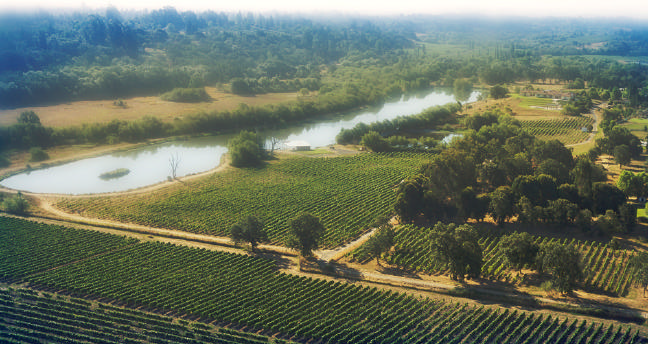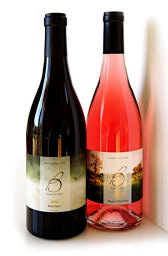Ski Green Valley
In my second life, I want to come back as someone like Gerald Bybee. He and his
wife Shaun, own a piece of paradise in the Green Valley appellation of Sonoma,
near the town of Sebastopol. On their total habitat of 86 acres, they have a thriving
Pinot Noir vineyard of 14 acres and a large lake with a professional water ski slalom
course! To me, this is nirvana, since I grew up waterskiing from a very young age.
Forwards, backward, barefoot, pyramid, jumps, you name it, I did it on water skis. I
used to say, “Hit It!” in my sleep. When I recently visited the B Vineyards & Habitat,
I wanted to get out on that pristine lake right there and then. (See aerial photo on
page 2).
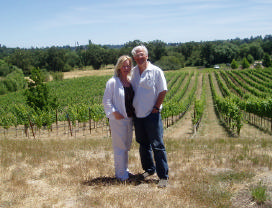
Gerald Bybee is an award-winning advertising photographer and fine-artist who
has done a number of photoshoots for wineries. Shaun Bybee is a former model,
CEO of Make-up Studio U.S.A. and President of the Board of Summerfield Waldorf
School in Santa Rosa. About 12 years
ago, Gerald and Shaun wanted to
leave their home in San Francisco to
acquire a wine country property.
They came upon a neglected agricultural
and open-space habitat that had
originally been the home of Miller
Dairy, the last certified raw milk producer
in Sonoma County. The original
dairy processing building still stands
on the property and now serves as a
place for equipment and barrel storage,
but one day may be converted
into the B Winery.
Although initially, they had no plans to grow grapes, it seemed only natural since
their property sat adjacent to the 30-year-old Hartford Family Arrendell Vineyard.
The area presented many challenges because it sat in the nutrient-rich and water-laden
flood plain near Atascadero Creek. The usual vineyard pests, birds, gophers, and deer were plentiful. The microclimate did offer ideal conditions for Pinot Noir:
morning fog, sandy-loam, and Goldridge soils, and one of the coolest climates in
the Russian River Valley.
The aerial photo of the B Vineyards & Habitat shows Hartford Family Arrendell Vineyard in the foreground,
the B lake, pond, and open space habitat as well as several blocks of B Pinot vines, with the
estate residence in the distance.
Gerald asked noted winegrower Warren Dutton to visit after they acquired the property in 1996. He
advised Gerald to rehabilitate the ponds (there were originally five ponds that became a singular
lake) and improve the drainage on the habitat. After this was undertaken, Dutton made a return visit
and through his encouragement and assistance, a Pinot Noir vineyard was planted in 2000 and 2001.
The clones are Pommard, 114, 115, 667, and 777. Shaun is a passionate supporter of organic farming
and a clean environment and has directed the organic and biodynamic practices on the property
(organic certification came in 2003). The B estate vineyard is the only organically certified Pinot Noir
vineyard in the Green Valley district of the Russian River Valley.
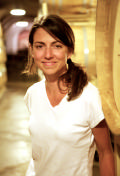
The first wine grapes were harvested and marketed to Patz & Hall, Lynmar Winery,
and Lutea in 2004. In 2005, the Bybees began a collaboration with winemaker
Suzanne Hagins (right) to produce a premium estate Pinot Noir. Hagins learned
winemaking hands-on with experience at Domaine Comte Armand in Pommard,
France, DeLoach Vineyards in the Russian River Valley, David Bruce in the Santa
Cruz Mountains, and Goldeneye in the Anderson Valley. She also crafts fine wine
under her own label, Lutea in Santa Rosa. She hails from South Carolina where she
is a “Rock Star in the Wine World,” and wine enthusiasts there gobble up over 150
cases of her Lutea Pinot Noir every vintage. In addition, her Lutea Pinot Noir is being
poured by many Sonoma restaurants such as Cyrus, the Farmhouse Inn, the
Starlight Wine Bar, and the Carneros Bistro and Wine Bar.
Each of the blocks in the B estate vineyard is picked and vinified separately. A fine rosé is made
from a selected block. Winemaking is traditional with an emphasis on elegance and complexity.
Shaun says that the B wines “are meant for those with not only a great understanding of Pinot Noir and
all of its intricacies, but also an appreciation of the dedicated farming practices that ultimately determine
what ends up in the glass.”
2006 B Vineyards & Habitat Rosé of Pinot Noir
13.0% alc., 120 cases, $24.
·
A dry rosé with an appealing light crimson color, this is a thoroughly
satisfying aperitif or summer food wine. The flavors are driven by red fruits,
primarily ripe strawberries, with a hint of spice and herbs. Strawberry Fields
Forever.
2005 B Vineyards & Habitat Green Valley/Russian River Valley Estate Pinot Noir
13.9% alc., 210 cases, $55. Hand picked, carefully
sorted grapes underwent de-stemming, cold-soak and gentle pressing
using a small Italian basket press. The wine was aged 10 months in caves
using lightly toasted new and used French oak barriques, and bottled-aged
6 months before release.
·
This is one great Pinot powered by wild strawberries,
cherries and exotic oak highlights in the aromas and flavors. A hint of
root beer adds interest. The texture is supple and there is plenty of bright
acidity. This is one of those Pinots that you can sniff for 20 minutes after the
glass is emptied and only a small dollop remains in the bottom. You simply
can’t take your nose out of the glass. Dreamy musk, crushed cherries, spice and freshly-sanded mahogany
waft from the glass. It is enough to make a grown man smile from ear to ear.
B Vineyards & Habitat wines may be purchased from the website at www.bpinot.com or
www.bybee.com. Sign up for the mailing list here, check out the blog, and be sure and view the beautiful
photography of the property taken by Gerald. If you like wildlife and Pinot, make an appointment
(707-823-9040) to visit and taste. You might see Shaun walking the vineyards row by row with Suzanne
as she does every week or Gerald out on the lake catching a ride.
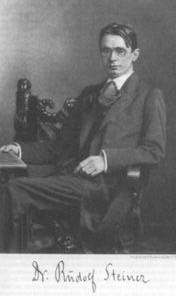
*A side note worth discussing. I had no idea the Austrian philosopher and
educator, Rudolf Steiner, had such far-reaching influence in many areas of
philosophy, education, and anthroposophical medicine. Among wine
circles, he is most famous for his theories of biodynamic agriculture. The
basic tenant of biodynamic farming is the so-called self-contained “farm
organism.” The farm is viewed as a self-nourishing organism and none or
few outside materials need be brought onto the farm. The Bybees
explained to me that Steiner was also the founder of the Waldorf education
movement in which the arts and farming are emphasized along with the
basic subjects of learning. Today, there are over 900 independent
Waldorf schools worldwide, including one in Sebastopol, Sonoma County.
To explore Steiner’s works in more detail, go to the website,
www.rudolfsteinerweb.com.




